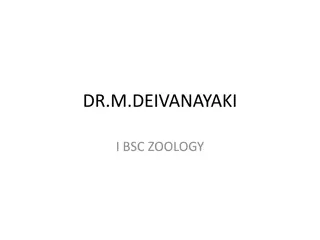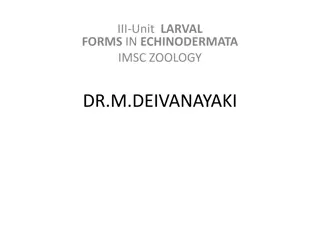Starfish: Fascinating Echinoderms of the Ocean Depths
Starfish, also known as sea stars, are marine invertebrates belonging to the class Asteroidea. With roughly 1,500 species found worldwide, these creatures play essential roles in various ecosystems. Their unique anatomy includes a water vascular system for movement and feeding. Starfish have intricate life cycles, diverse feeding behaviors, and the ability to regenerate lost parts. Despite their ancient history and ecological significance, they are also culturally significant and have inspired art, literature, and design.
Download Presentation

Please find below an Image/Link to download the presentation.
The content on the website is provided AS IS for your information and personal use only. It may not be sold, licensed, or shared on other websites without obtaining consent from the author.If you encounter any issues during the download, it is possible that the publisher has removed the file from their server.
You are allowed to download the files provided on this website for personal or commercial use, subject to the condition that they are used lawfully. All files are the property of their respective owners.
The content on the website is provided AS IS for your information and personal use only. It may not be sold, licensed, or shared on other websites without obtaining consent from the author.
E N D
Presentation Transcript
Starfish- UNIT-V DR.M.DEIVANAYAKI
Starfish or sea stars are star-shaped echinoderms belonging to the class Asteroidea. Common usage frequently finds these names being also applied to ophiuroids, which are correctly referred to as brittle stars or basket stars. Starfish are also known as Asteroidsdue to being in the class Asteroidea. About 1,500 species of starfish occur on the seabed in all the world's oceans, from the tropics to frigid polar waters. They are found from the intertidal zone down to abyssal depths, 6,000 m (20,000 ft) below the surface. Starfish are marine invertebrates. They typically have a central disc and usually five arms, though some species have a larger number of arms. The aboral or upper surface may be smooth, granular or spiny, and is covered with overlapping plates. Many species are brightly coloured in various shades of red or orange, while others are blue, grey or brown. Starfish have tube feet operated by a hydraulic system and a mouth at the centre of the oral or lower surface. They are opportunistic feeders and are mostly predators on benthic invertebrates. Several species have specialized feeding behaviours including eversion of their stomachs and suspension feeding. They have complex life cycles and can reproduce both sexually and asexually. Most can regenerate damaged parts or lost arms and they can shed arms as a means of defense. The Asteroidea occupy several significant ecological roles. Starfish, such as the ochre sea star (Pisaster ochraceus) and the reef sea star (Stichaster australis), have become widely known as examples of the keystone species concept in ecology. The tropical crown-of-thorns starfish (Acanthaster planci) is a voracious predator of coral throughout the Indo-Pacific region, and the northern Pacific sea star is considered to be one of the world's 100 worst invasive species. The fossil record for starfish is ancient, dating back to the Ordovician around 450 million years ago, but it is rather sparse, as starfish tend to disintegrate after death. Only the ossicles and spines of the animal are likely to be preserved, making remains hard to locate. With their appealing symmetrical shape, starfish have played a part in literature, legend, design and popular culture. They are sometimes collected as curios, used in design or as logos, and in some cultures, despite possible toxicity, they are eaten.
Body wall The body wall consists of a thin cuticle, an epidermis consisting of a single layer of cells, a thick dermis formed of connective tissue and a thin coelomic myoepithelial layer, which provides the longitudinal and circular musculature. The dermis contains an endoskeleton of calcium carbonate components known as ossicles. Water vascular system The water vascular system of the starfish is a hydraulic system made up of a network of fluid-filled canals and is concerned with locomotion, adhesion, food manipulation and gas exchange. Water enters the system through the madreporite, a porous, often conspicuous, sieve-like ossicle on the aboral surface. It is linked through a stone canal, often lined with calcareous material, to a ring canal around the mouth opening. A set of radial canals leads off this; one radial canal runs along the ambulacral groove in each arm. There are short lateral canals branching off alternately to either side of the radial canal, each ending in an ampulla. These bulb-shaped organs are joined to tube feet (podia) on the exterior of the animal by short linking canals that pass through ossicles in the ambulacral groove. There are usually two rows of tube feet but in some species, the lateral canals are alternately long and short and there appear to be four rows. The interior of the whole canal system is lined with cilia. Digestive system and excretion The gut of a starfish occupies most of the disc and extends into the arms. The mouth is located in the centre of the oral surface, where it is surrounded by a tough peristomial membrane and closed with a sphincter. The mouth opens through a short oesophagus into a stomach divided by a constriction into a larger, eversible cardiac portion and a smaller pyloric portion. The cardiac stomach is glandular and pouched, and is supported by ligaments attached to ossicles in the arms so it can be pulled back into position after it has been everted. The pyloric stomach has two extensions into each arm: the pyloric caeca. These are elongated, branched hollow tubes that are lined by a series of glands, which secrete digestive enzymes and absorb nutrients from the food. A short intestine and rectum run from the pyloric stomach to open at a small anus at the apex of the aboral surface of the disc Sensory and nervous systems Although starfish do not have many well-defined sense organs, they are sensitive to touch, light, temperature, orientation and the status of the water around them. The tube feet, spines and pedicellariae are sensitive to touch. The tube feet, especially those at the tips of the rays, are also sensitive to chemicals, enabling the starfish to detect odour sources such as food
Circulatory system The body cavity contains the circulatory or haemal system. The vessels form three rings: one around the mouth (the hyponeural haemal ring), another around the digestive system (the gastric ring) and the third near the aboral surface (the genital ring). The heart beats about six times a minute and is at the apex of a vertical channel (the axial vessel) that connects the three rings. At the base of each arm are paired gonads; a lateral vessel extends from the genital ring past the gonads to the tip of the arm. This vessel has a blind end and there is no continuous circulation of the fluid within it. This liquid does not contain a pigment and has little or no respiratory function but is probably used to transport nutrients around the body. Sexual reproduction Most species of starfish are gonochorous, there being separate male and female individuals. These are usually not distinguishable externally as the gonads cannot be seen, but their sex is apparent when they spawn. Some species are simultaneous hermaphrodites, producing eggs and sperm at the same time and in a few of these, the same gonad, called an ovotestis, produces both eggs and sperm.[29]Other starfish are sequential hermaphrodites. Protandrous individuals of species like Asterina gibbosa start life as males before changing sex into females as they grow older. In some species such as Nepanthia belcheri, a large female can split in half and the resulting offspring are males. When these grow large enough they change back into females. his enlarges and extends around the surface and eventually onto two developing arm-like outgrowths. At this stage the larva is known as a bipinnaria. The cilia are used for locomotion and feeding, their rhythmic beat wafting phytoplankton towards the mouth The next stage in development is a brachiolaria larva and involves the growth of three short, additional arms. These are at the anterior end, surround a sucker and have adhesive cells at their tips. Both bipinnaria and brachiolaria larvae are bilaterally symmetrical. When fully developed, the brachiolaria settles on the seabed and attaches itself with a short stalk formed from the ventral arms and sucker. Metamorphosis now takes place with a radical rearrangement of tissues. The left side of the larval body becomes the oral surface of the juvenile and the right side the aboral surface. Part of the gut is retained, but the mouth and anus move to new positions. Some of the body cavities degenerate but others become the water vascular system and the visceral coelom. The starfish is now pentaradially symmetrical. It casts off its stalk and becomes a free- living juvenile starfish about 1 mm (0.04 in) in diameter. Starfish of the order Paxillosida have no brachiolaria stage, with the bipinnaria larvae settling on the seabed and developing directly into juveniles.
Asexual reproduction Some species of starfish are able to reproduce asexually as adults either by fission of their central discs[45]or by autotomy of one or more of their arms. Which of these processes occurs depends on the genus. Among starfish that are able to regenerate their whole body from a single arm, some can do so even from fragments just 1 cm (0.4 in) long.[46]Single arms that regenerate a whole individual are called comet forms. The division of the starfish, either across its disc or at the base of the arm, is usually accompanied by a weakness in the structure that provides a fracture zone Regeneration Some species of starfish have the ability to regenerate lost arms and can regrow an entire new limb given time























